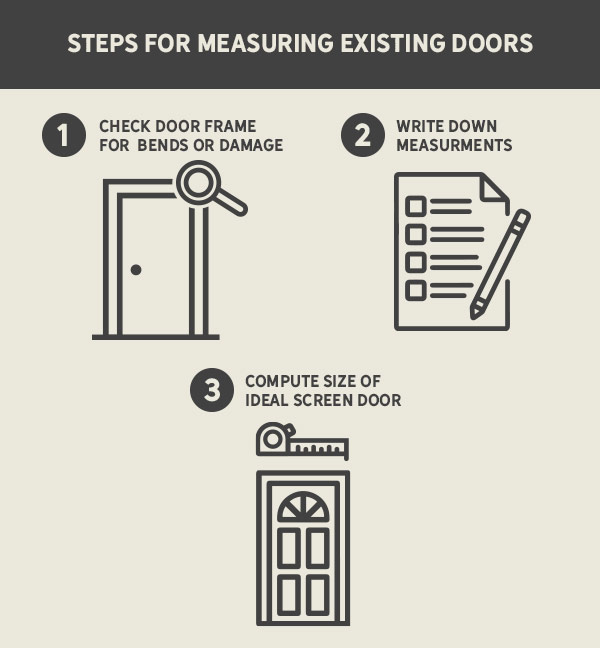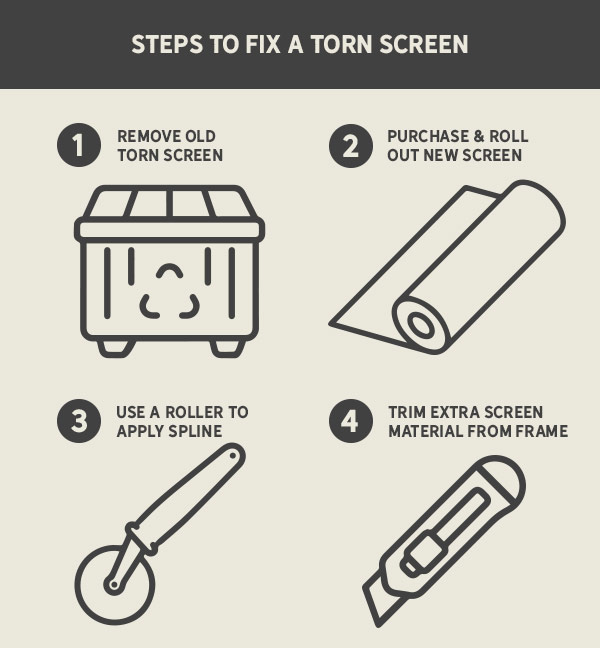

Tips on Installing a Screen Door
If you want a breeze without the bugs, a screen door offers a perfect solution. If your home lacks a screen door, you can easily install one yourself in an afternoon. Same goes for when you already have a screen door in place, but it’s in need of some repair. We’ll show you how this DIY is an easy one to cross off your to-do list, with a little help from McCoy’s.

Measure First

As tempting as it may be to run out to the store immediately, you should first take stock of your current screen door (or the doorway where you want to install one).
- Step 1: Check an existing screen door for any bends or damage in the frame. If it’s bent, you’ll want to replace it entirely, instead of attempting to repair it. The reason for this is that a bent frame metal will become weaker as you bend it again and is difficult to maintain its structural integrity.
- Step 2: If you’re replacing or installing a new door, make sure to first write down measurements of your door jam, noting its height and width in 3 different places (for accuracy).
- Step 3: Compute the size of your ideal screen door which should leave 3/16 of an inch gap between the screen door and the door frame sides. Note: Many come in standard frame sizes, such as 3’0” x 6’8” and 2'8" x 6'8", both of which are available at McCoy’s stores.
Types of Screen Doors
You can truly customize your screen door to fit your home’s design or your needs. If you have a large dog, you may want one with a solid lower half so it can’t bust through the screen to chase every mailman. Or, if your kids slam the screen door all day long, you may want to include a pneumatic door jack to keep your home quieter. Remember that screen doors aren’t meant to provide security, like a lockable storm door, and they won’t keep the elements out of your home.
Different screen frame materials include vinyl and aluminum (sometimes offered in pre-painted designs) or wood, which can be custom painted to match your home’s trim or add a bit of flair to a gloomy doorway. You can find plain screen doors with two simple top and bottom panels, or decorative options with a variety of screen or solid panels. Screen mesh can also come in a variety of materials and tones, from fiberglass to aluminum, and dark gray or black to a copper tone.
If you want to truly DIY this project, you can even build your own screen door from scratch! If you want a truly unique doorway and you’re up for a project that’s a bit more complex, consider making your own door with supplies you can find at McCoy’s.
What's Needed: Hardware and Tools Required
You’ll notice on the McCoy’s website, we offer several “screen door kits” that come with all the hinges, handles, and even latches you’d need for installation. But you’ll also need a few more items to get your project going.
Make sure you have:
- Hinges and pulls/handles/doorknobs (can be purchased in a kit, mentioned above)
- Catch or stop to match hardware (check your kit if you purchase one)
- Spring (also often included in a kit)
- Drill and bits
- Shims
- Measuring Tape
- Pencil
Basic Installation (and Some Tips and Tricks)
There isn’t exactly one size that fits all with screen door installation, and you’ll want to check your specific type, along with its brand for detailed steps. However, there are some basic considerations you’ll want to keep in mind to install a screen door.
- Does the door swing open left or right? This will impact which side the hinges and door handle end up on. You’ll want your hinges on the same side as your existing door hinges. Many pre-made screen doors come with hardware that’s reversible, so you will have to ensure you’re accurate in installing to the correct side.
- Use shims before installing. Shims are small wedges, often made of wood, that you can use to sit the uninstalled door in place in the doorway. This way you can raise up the screen door to get it perfectly evenly positioned from side to side and top to bottom.
- Do some marking, before you drill. To ensure the perfect hinge and handle placement, use your pencil to mark where your drill holes will be.

A Quick Way to Fix a Torn Screen

If you’re just here for the torn screen repair tips, these are the basics:
- First, remove the old, torn screen from the door.
- Purchase and roll out a roll of replacement screen that is the same type as the existing screen in other parts of the door.
- You can trim your screen using a straight edge now (allowing several inches of overlap) or use your roll or large piece of screen as-is. Line up your replacement screen as evenly as possible, and use a blunt tool (a flat-head screwdriver, for example, or you can also use a screen installation tool) to push the mesh into the grooves at the edge of the frame.
- Trim excess screen mesh.
McCoy's Has Everything You Need
From a big undertaking to a quick project, McCoy’s has the expert experience and quality materials to get this project off your To-Do list and onto your Done list. Ask us about what type of screen door is right for your home, and by tonight you could be enjoying some lovely breezes and the sounds of nature right from your own backyard.
